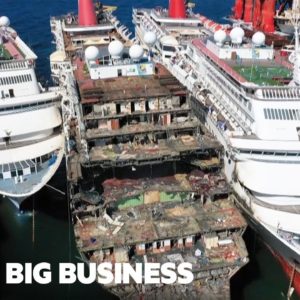for these 300 million dollar cruise ships this is the end of the line because of the pandemic carnival costa and pullman tour cruise lines have all sent ships to western turkey for demolition here they'll be ripped to shreds deck by deck and sold for parts but dismantling a ship that holds 2 thousand passengers well that's one of the most dangerous jobs in the world shipbreakers saw off massive sections of the hull and move them overhead there's millions of dollars worth of parts at stake but any misstep could mean injury or hurting the environment and it's only gotten harder with lots of new arrivals we take you inside the yard turning these floating hotels into this before the pandemic the aliaga shipbreaking yards were pretty quiet normally the 22 yards only demolished a few dozen cargo ships a year but when the pandemic wrecked the cruising industry more and more cruise ships ended up here after losing more than four billion dollars in the second quarter of 2020 carnival cruise line decided it was more affordable to sell its old ships for parts than try to keep them operating aliaga will be the last stop for carnival's inspiration imagination and fantasy ships captains navigate the cruise liners from the us uk and italy they coordinate with the harbour master to beat ships then the ball front of the vessel is grounded on the shore while the stern still floats we plan how we cut the vessels together with our technical department then 2500 ship breakers set out to remove any valuable material there are very expensive navigational equipments at bridge site working one deck at a time crews take out all the furniture mostly by hand we're talking everything from chairs tables and pianos to light fixtures and beds i can easily say that cruise vessels are the hardest vessel type to dismantle because you know there are hundreds of rooms on board then they move on to amenities dismantling gyms pools and theaters stripping walls windows floors and handrails is next this is where lots of saws and blow torches come in workers risk daily falling from great heights inhaling toxic gases during cutting operations being hit by falling objects and the blowtorch comes with fire hazards they are working in very high degrees under the sun in some times or they are working in very extreme conditions in wintertime since october 2020 two workers have died from falling objects the vessel lies on water so there is no any way for the ambulance to reach in case of emergency situations despite these injuries working conditions in aliaga are better than those of the world's biggest ship breaking yards in south asia in bangladesh and pakistan where most of the end of life vessels end up every year dozens of people die or get injured in the process those yards in south asia use the dangerous gravity method it is dropping huge blocks into the water onto the beach but in turkey workers lift ship parts with a massive crane which has a 2000 tone capacity in our shore site and we cut big blocks at the vessel and by using this huge crane we take these big blocks at our secondary cutting zone aliaga hasn't always had the safest yards in the late 90s turkey was just as bad as south asia but in 2002 greenpeace released a report that revealed the unsafe work conditions here and the world took notice as a reaction to these international criticism things have improved considerably things got even safer in 2018 when some aliaga yards started complying with the european union shipbreaking regulation that's why carnival chose two yards here for its end-of-life ships those eu guidelines have also raised the standards for environmental practices every cruise ship has dozens of toxins hidden inside things like asbestos and pipes heavy metals and paints biological hazards from sewage tanks radioactive material from gages and the list goes on left unchecked they can seep into the soil beach and water where they've destroyed local marine habitats and water systems around shipwrecking yards before but because of these new regulations aliaga got newer and better drainage systems and cement floors in the secondary cutting area so workers weren't cutting ship parts on open beach they also got new oil booms for containing oil spills a new waste management center for properly disposing of those toxins in the ship and a better asbestos removal process practices have been proved but there are still concerns related to the long-term impact on the health of the workers due to exposure to toxic substances nicola says many workers aren't aware of these risks and the rest choose the job anyway because of the high pay only after the ship is demolished this is all that's left while the whole process takes six months for a cargo ship it takes a lot longer for a cruise ship almost one year maybe more workers move everything pulled off the ships into separate piles electronics light fixtures textiles furniture glass and machinery memorabilia claimed the life jackets art and maps from antique sellers but what about all that metal gaming method in 2020 omil estimates workers pulled over a million tons of steel off cruise ships here and that'll all be recycled recycling steel instead of mining the raw materials reduces definitely energy requirements and in the carbon footprint it's estimated scrap metal from one ship could pull in around four million dollars in profit for the ship breaking association you can make good money because there are lots of things on board for second and sales demolishing these bigger ships has led to larger profits and a growing workforce for aliaga shipyards it comes on the heels of a crumbling cruise industry you


